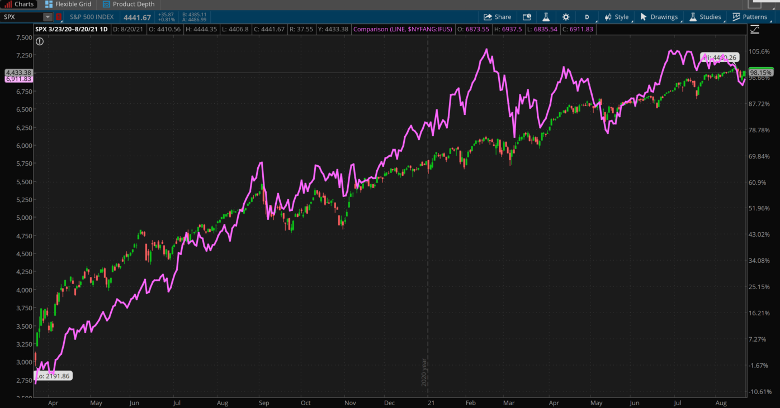The fresh air of Wyoming beckons this week, but it will have to be from a distance as Fed Chairman Jerome Powell and company prepare for a virtual Jackson Hole symposium.
Powell’s keynote speech doesn’t happen until Friday morning at 10 ET. It’s titled simply, “The Economic Outlook.” Many analysts expect Powell to not only review where the economy has been and might be going, but to also explain the framework of pulling back the $120 billion a month stimulus that’s been constant since Covid began.
No one is certain this will happen, but the Fed has certainly been telegraphing it since roughly mid-June. Making things even harder to figure out, the speech comes as Covid’s Delta variant creates new uncertainty in the U.S. and overseas, with lockdowns in parts of China and Australia and new mask mandates here at home. In one new development, Australia is hinting it may walk back its “zero Covid” policy amid protests against lockdowns there.
Data lately has been mixed, with several signs of weakness outside of a sizzling jobs market. The benchmark 10-year yield finished last week trading down more than 50 basis points from its March high, but inflation data continues to suggest possible overheating.
Don’t envy the Fed here. They have their hands full, and whatever they decide to do, some part of the market, business world, or government is likely to be unhappy. There is a bit of optimism that Powell could pretty much stick to the dovish tone he’s taken most of the year, but we’ll have to wait and see.
Just one more Fed-related item: Treasury Secretary Janet Yellen is supporting a second term for Powell, according to Bloomberg News. It’s unclear when President Biden might weigh in, but this could help Powell’s chances.
The market continues to power higher, perhaps because some investors remember the old Wall Street adage about “never selling a dull market.” And it could be dull this week ahead of the Powell speech. Data and earnings are thin.
Crude, Yields Bounce Back from Last Week’s Lows
There’s more than Jackson Hole this week. Crude finished Friday at new three-month lows down around $62, hurt by economic growth concerns. It bounced back to $64 this morning after seven straight down days and a 20% drop from its peak. The benchmark 10-year Treasury yield is up a bit, too, at 1.27%. Checking volatility, it’s down from last week’s highs but still elevated from recent lows.
Today brings existing home sales for July, and Thursday will feature the updated government GDP estimate. New home sales tomorrow also could be worth a look to see if high prices and limited supply continue to burden buyers. Friday marks the date for an important inflation indicator, the personal consumption expenditures (PCE) price report.
Also, don’t forget infrastructure. This week could include some votes in the House as that chamber looks over the plan. It passed the Senate a couple weeks ago.
Market Remains Resilient Even as Rally Slows
Last week ended with a solid Friday rally, and it was really amazing how the markets kept bouncing back from selling pressure the last few days. Though the S&P 500 Index (SPX) did fall slightly for the week, it wasn’t the kind of big selloff many had expected following a couple of very iffy sessions and opening losses. Each time that happened, the buyers stepped back in so quickly it was pretty much over by midday. “Buy the dip” has underpinned the market all year and seems to be alive and well. Still, trading might lack conviction in the days ahead as people wait to hear what Powell has to say.
It’s one of those times where strength in the major indices can be a bit misleading, because so much of it lately has come from the so-called “mega-cap” Tech stocks. Friday was a good example, as several companies with monster market-caps like Apple (NASDAQ:AAPL), Microsoft (NASDAQ:MSFT), and Nvidia (NASDAQ:NVDA) led the way. These huge companies can throw their weight around in the indices, pulling them up or down through their sheer massiveness. Still, having said that, every sector rose on Friday, so it wasn’t a one-trick pony.
Overall, though, the “stay at home” stocks seem to be pulling away a bit from the cyclicals as people worry about the Delta variant’s impact. Technology and Communication Services were two of Friday’s leading sectors, while Energy, Industrials, and Financials didn’t show as much spark.
If you were looking for spark on Friday, NVDA was one place to find it. Shares climbed to near their all-time high after the company’s solid earnings report. NVDA didn’t report a huge earnings per share beat, but they’re on the cutting edge of so many aspects of Tech including video gaming, artificial intelligence and automated vehicles, and their market share gains have been impressive. Meanwhile, MSFT may have gotten a lift through its announcement of price increases for its popular Office 365 and Microsoft 365 products.
More Thoughts on Potential Taper
It’s not just a matter of whether the Fed will taper its $120 billion a month stimulus. It’s how long the process might take. A slow, measured taper, which many analysts expect, might soothe investors.
One thought is that the Fed might want to evaluate economic data following a month or two of tapering before pulling the trigger on another round. This isn’t like 2013, when a Fed taper announcement surprised the market and dragged stocks. That could still happen, but it seems like the Fed has done a good job telegraphing the move, and it could ease the transition by making it clear nothing will happen too quickly or dramatically.
In fact, a taper, if it happens, could be seen as bullish. After all, the Fed wouldn’t contemplate pulling the punch bowl away if it continued to have lots of doubts about the economy. Employment numbers continue to move in a positive direction despite the Delta variant, as the light weekly jobless claims showed.
Chart of the Day: Thanks For The Lift
China’s Problems Aren’t Just China’s
If you’re worried about a slowing Chinese economy, it’s not just Chinese companies to think about. Some of the biggest U.S. multinationals across many sectors have a lot of exposure to China. We’re talking about the Apples, Boeing (NYSE:BA), General Motors (NYSE:GM), Caterpillars (NYSE:CAT), Nikes (NYSE:NKE), and Teslas (NASDAQ:TSLA) of the world. BA shares took a beating as the company still waits for China to allow flights of BA’s 737 MAX.
Anyway, for investors who jumped into shares of foreign companies this year thinking it would finally be a year when those markets outperformed the U.S., it’s been a rude awakening so far. Chinese stocks are down a fraction year-to-date, compared with 17% gains for the SPX. Having said that, there is a historical pattern of Chinese indices falling sharply from their highs over the years and then making fierce comebacks. No guarantee of that happening again, of course, and Hong Kong’s market is now down 20% from its peak, the definition of a bear market.
Dialing Back GDP
Thanks to the Delta variant, economists are starting to reduce their estimates for U.S. Q3 gross domestic product growth. Last week, Goldman Sachs drew some headlines by lowering its estimate from 9% to 5.5%, citing Delta’s impact on growth and inflation. The effect of Delta, GS said, has been bigger than it had expected. On a similar note, Bank of America just last month slightly lowered its GDP forecast from 7% to 6.5% for the remainder of the year. The Atlanta Federal Reserve’s GDP Now monitor now pegs Q3 GDP at 6.1%, down from an earlier estimate of 6.2%. Softer data from the housing market helped send the projection lower.
If you wonder why GDP is important or why people care, it’s because the data truly show productivity of the country and whether our economy is growing or sinking. That can help you to set long-term prospects for the equities or indices you invest in. Breaking it down a bit more, it measures personal consumption expenditures, gross private investment, net exports (the difference between what the United States sells abroad and what it imports) and government spending. This Thursday brings the government’s second estimate for Q2 GDP. Last time out, it came in at 6.5%. However, that’s a trailing indicator. The road ahead is what people are probably focused on.
Stormy Weather
Amid worries about the Delta variant, the Fed, China, and geopolitics, a seasonal concern also looms. It’s the heart of the Atlantic hurricane season, something that often raises some waves around the market this time of year. Forecasters say Tropical Storm Henri is expected to strengthen and become a hurricane with a forecast track taking it toward New England. Things have otherwise been pretty quiet so far, with only two Category 1 hurricanes recorded since July. But it’s still early. The infamous Hurricane Katrina that slammed New Orleans in 2005 did most of its damage in late August. Hurricane Sandy hit the entire eastern seaboard in October 2012.
Hurricanes can upend the crude industry and cause turbulence in the oil market by limiting or even shutting down off-shore production in the Gulf of Mexico. They can also have major regional impacts on the Consumer Discretionary sector, with hotels, casinos, restaurants and other industries seeing business battered. One of the worst recent hurricanes, Harvey in 2017, killed 107 people in the U.S. and caused $125 billion in damage. A really major hurricane like Harvey can sometimes have an impact on the U.S. job market, initially causing major job losses in the services industry. Sometimes those jobs end up coming back in a big wave months later, and that can distort the overall jobs picture and make it harder to get a sense of the underlying economy. Considering all the other non-weather related storms raging, let’s hope calm prevails on the high seas.

